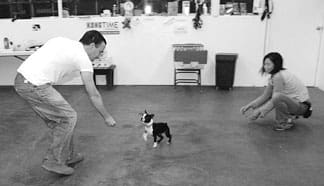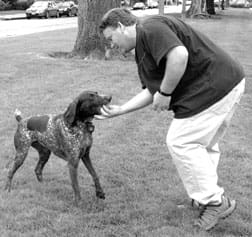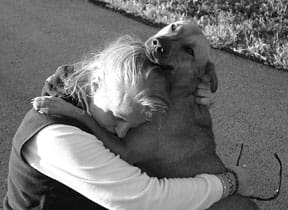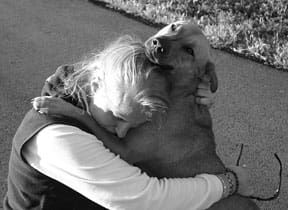By Pat Miller
Science and common observation tells us that male and female brains are different. That’s no surprise to anyone who has noticed the gender-related differences that often occur in relationships between men, women, and their canine companions. Some of the differences can be beneficial, while others may be detrimental to domestic tranquility as it relates to life with the family dog.
The question is, which differences should be nurtured and encouraged? Which ones need to be addressed to prevent the dog from being confused and creating behavior problems? And how can that be accomplished?
In general, men tend to be more physical with their dogs, and more assertive, enjoying rough-and-tumble wrestling games and expecting the dog to understand and obey. Women tend to be softer, more into cuddling than wrestling, and take more interest in teaching the dog to understand the complex world of primate (human) communication. Of course, these are generalizations; there are certainly men who like to cuddle their dogs and women who are into canine wrestling matches!
A time to be physical

324
The same physical behavior may be appropriate with one dog and inappropriate with another. My own husband enjoys more physical interaction with our dogs than I do. This works out fine with Tucker, our 70-pound Cattle Dog-mix, who gets a wild-eyed look and a huge grin on his face when Paul starts pushing and grabbing at him, or teases him by slapping at his paws. With excellent bite inhibition, Tucker enjoys the interactions with open mouth and fierce growls, but in 13 years of rough play has never put a tooth on human skin.
For Tucker, Paul’s physical games are appropriate and acceptable. Just last week, however, I had to remind my beloved that paw-slapping is not appropriate play for Lucy, our two-year-old Cardigan Corgi. This is especially true when she’s chewing a bone, because she has mild resource-guarding behaviors that could easily be exacerbated by confrontational games, and has always tended toward being mouthy.
When a family member insists on physical interactions with a dog like Lucy, the solution is to agree on physical games that don’t reinforce inappropriate behaviors. My favorite for this is Tug of War – with rules. (See “Tug: Play It by the Rules,” October 2004.) The dog’s teeth are directed to an acceptable tug object rather than human skin, and dog and human can be as rough as they like as long as it’s mutually enjoyable to both parties, and both can play by the rules. A valuable side effect to Tug is that, properly played, it reinforces a healthy hierarchy between dog and human, as the human most often ends up in possession of the tug prize. A good leader controls the good stuff.
On the gentler side of Tug, the game can be used to elevate status for a dog like our Bonnie Wee Lass, a Scottie/something mix who, at the age of one year, is finally outgrowing her submissive urination behavior. Because I play more softly than Paul, I’m a better Tug partner for Bonnie, deliberately avoiding rough play that might intimidate her, and letting her win the game far more often than I let her assertive packmate, Lucy, end up with the prize.
Other more physical interactions that may appeal to the “Men Being Men” dog-owning set include high-arousal canine activities like agility. Even men who aren’t into canine competition (which seems to be more popular with women, perhaps because of the precision and discipline required) can romp with their dogs just for fun over agility and natural obstacles. Many men revel in their dogs’ athletic ability as they leap over jumps and navigate teeters and fallen logs. Dock diving, where dogs leap long distances off docks and splash-land in water to retrieve objects, also tends to appeal to many men.
It’s important to recognize and acknowledge the value of physical games. They can be great exercise when done appropriately. They’re also great relationship builders. A rousing game of Tug can be a great stress and exercise reliever for a high-energy canine suffering from cabin fever due to inclement weather. Don’t grudgingly tell your partner, “All right, if you must roughhouse with the dog, go ahead, as long as you do it the right way . . .” Instead, let him know how much you appreciate him playing with and exercising the dog. Help him understand why game rules are important, and reinforce him for playing by the rules. Humans respond well to positive reinforcement, too!
Presence

252
The male voice is more intimidating to most dogs than softer, higher-pitched female tones. Without even thinking about it, men can “command” obedience from dogs, eliciting appeasement behaviors with their naturally deeper, louder voices, larger physical form, and generally more assertive presence.
Of course, men can overdo intimidation, causing dogs, especially those with soft personalities, to shut down, withdraw, even become fearful in response to the male presence. In fact, if the male partner overdoes the intimidation thing, constantly using a stern voice to get the dog to comply with “commands,” it can interfere with a female partner’s ability to succeed with a gentler training approach.
Women are often magically adept at helping a soft or shy dog build confidence and getting dogs to happily buy into a training program. Their softer body image, higher pitched voices, and greater willingness to be silly can result in dogs who offer uninhibited, joyful behaviors in training and relationship. On the other hand, some women can overdo “soft and silly,” to the point the dog may have difficulty taking them seriously.
It’s vital to recognize the value in both the male and female style of interacting with dogs. Each gender can benefit by deliberately learning to use tools of the other and to dampen their own gender-related behaviors when appropriate to enhance their communications skills with their dogs. Dogs can benefit if partners have discussions about how their personal styles and relationships with their dogs differ, which parts benefit the training program, and which of their own human behaviors they might strive to modify to achieve the greatest success.
Tips for mom ’n pop training:
If you and your partner don’t yet have a dog, talk about gender-related differences and how closely you each fit your gender stereotype or not. Be sure to look for a dog who can accommodate your styles. If either partner is very loud and assertive, avoid very soft canine personalities. If either partner is very soft and non-assertive, avoid very strong, pushy dogs. It’s not fair to get a dog who’s poorly suited to one human style or the other and expect the partner to change overnight to be able to cope with the dog’s training needs.
If you already have your dog, you can:
• Acknowledge that there are good and not-so-good things about both gender training styles and agree to work on them together. Sit down with your partner and discuss how your training and relationship styles and preferred activities differ.
• Make a list of interactions that each partner has with the dog, and agree on which are beneficial and which are detrimental. A sample list might look something like this:
Man – Can get the dog to sit or come reliably and consistently using a deep, calm voice (beneficial); encourages the dog to jump up (detrimental); plays Tug with the dog (beneficial) but doesn’t always play by the rules (detrimental); usually feeds dog (beneficial) but is too casual about feeding, setting the bowl onto floor as dog dances around and jumps up (detrimental); always requires the dog to sit calmly to attach leash to go for walk (beneficial) but yells at the dog if he doesn’t sit promptly (detrimental); and takes the dog for long hikes (beneficial).
Woman – Takes dog to training classes and practices daily (beneficial), but often “chatters” to the dog during training, to the point that the dog tunes her out (detrimental); is consistent about using treat rewards and other reinforcers for desirable behaviors (beneficial), but sometimes reinforces inappropriate behaviors because they’re “cute” (detrimental); routinely grooms the dog, using positive reinforcement and desensitization to help dog enjoy the grooming experience (beneficial); has the dog sit at the door to go outside (beneficial), but sometimes lets the dog out anyway if she can’t get him to sit (detrimental); chases the dog when he grabs something he’s not supposed to have (detrimental).

288
• Agree to acknowledge (reinforce) each other for all the good stuff on the lists. The partners might agree to put a quarter (or a dollar!) in a rewards jar every time they see the other perform one of the beneficial activities. When the tally in the jar reaches a pre-determined amount, the partners can use it to pay for a fun date together (a weekend at a dog-friendly B&B?), or to buy something they both want.
• Agree to work on self-awareness corrections for detrimental behaviors. Whenever one partner realizes that s/he did one of the detrimental activities a quarter (dollar) goes in the corrections jar. Partners should avoid correcting each other; nothing goes in the jar for correcting your partner! Partners can use the money in the jar to buy agreed-upon toys, treats, and training equipment for the dog.
• Agree in advance to do it all in good humor, always remembering that it’s in the best interests of the dog, and of family harmony. Viva la difference!






